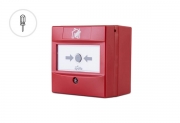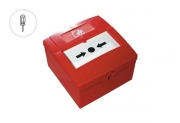-
Contact
Sales & Customer Service
0800 612 6537 support@safelincs.co.uk Live ChatDelivery Enquiries
0800 077 6149 - Resources
Fire & Safety Solutions
CALL OUR TEAM NOW 0800 612 6537
Lines open today 8am - 6pm
Free Delivery
on 100s of Products
Live Chat - Online
Instant help & Advice
Trade Discounts
and exclusive pricing
0% Credit Available
Open an account now
5 Star Customer Feedback
Fire Alarm Panels, Conventional, Addressable & Wireless Systems
Fire alarm systems protect lives and property by detecting fires early and alerting occupants to evacuate safely. Modern fire alarm systems provide reliable detection across residential, commercial and industrial buildings. The right fire alarm system depends on your building size, layout and specific fire safety requirements. Safelincs supplies three main types of fire alarm systems to meet different needs and budgets. Each system offers distinct benefits for fire detection and emergency response.
Read more about Fire Alarm Systems and FAQs...
Professional fire alarm system installation ensures compliance with British Standards and building regulations. Safelincs design, install and commission fire alarm systems across mainland UK. Commercial fire alarm systems require careful planning to meet fire safety legislation and insurance requirements. We work with architects, contractors and building managers to specify appropriate fire detection for each premises type.
Conventional Fire Alarm Systems
Conventional fire alarm panels suit most commercial premises including offices, shops, schools and apartment blocks. These systems divide buildings into zones, with each zone covering a specific area or floor. When a detector activates, the fire alarm panel shows which zone triggered the alarm.
A conventional fire alarm system consists of a central control panel connected to detection circuits. Each circuit monitors smoke detectors, heat detectors, manual call points and alarm sounders within that zone. Fire brigade crews can quickly identify the general area of the fire from the zone display.
Two wire and four wire conventional systems provide cost effective fire protection for medium sized buildings. The control panel continuously monitors all connected devices and raises the alarm when fire is detected.
Addressable Fire Alarm Systems
Addressable fire alarm panels offer precise fire location identification beyond basic zone information. Each detector and device has a unique address, allowing the control panel to pinpoint exactly which device activated. Instead of showing ‘Zone 2’, an addressable system displays specific locations like ‘Reception Desk Smoke Detector’ or ‘Kitchen Heat Detector’.
This intelligent addressing capability helps emergency services locate fires faster and respond more effectively. Addressable fire alarm systems also provide enhanced fault finding, showing exactly which device needs attention during maintenance.
Modern addressable panels support hundreds of individual devices across large commercial buildings, hospitals, schools and industrial facilities. The systems integrate smoke detectors, heat detectors, beam detectors, manual call points, sounders and visual beacons.
Wireless Fire Alarm Systems
Wireless fire alarm systems combine the intelligent addressing of conventional addressable systems with radio communication between devices. This eliminates most cabling requirements, reducing installation time and building disruption significantly.
Wireless fire detection proves ideal for historic buildings, listed properties and occupied premises where cable installation creates practical difficulties. The radio signal range allows flexible detector placement without running cables through walls, ceilings or floors.
Each wireless device communicates directly with the fire alarm panel using secure radio protocols. Battery powered detectors provide years of operation with minimal maintenance. Site surveys ensure adequate radio coverage before wireless fire alarm system installation begins.
Fire Alarm Servicing and Maintenance
Regular fire alarm servicing maintains system reliability and meets legal requirements. Our certified engineers provide nationwide fire alarm maintenance with full test certification. Annual servicing includes detector testing, battery replacement, panel checks and documentation updates.
Fire alarm systems require weekly testing by building occupants and professional maintenance every six months or annually depending on system type. We provide maintenance contracts to ensure ongoing compliance and peace of mind.
Frequently Asked Questions (FAQs)
What is the primary purpose of an automatic fire alarm system?
An automatic fire alarm system serves as an early warning network that detects fire conditions before they become life threatening. The primary purpose centres on protecting human life by providing rapid notification when smoke, heat or flames are detected within a building.
These systems monitor your property continuously, using sophisticated detection technology to identify fire signatures. When detectors sense danger, the fire alarm panel activates warning signals throughout the building, ensuring occupants hear the alert regardless of their location. This immediate response capability proves vital because fires can spread rapidly, often producing deadly smoke and toxic gases within minutes.
Beyond life protection, automatic fire alarm systems also protect property by enabling faster emergency response. The system can connect directly to monitoring centres or emergency services, reducing response times significantly. Early detection often means smaller fires that cause less damage and require fewer resources to extinguish.
Modern fire alarm systems integrate with other building safety features, including emergency lighting, access control and building management systems. This coordination ensures all safety measures activate simultaneously, creating a comprehensive protection environment that guides occupants to safety efficiently.
Can anyone install a fire alarm system?
Fire alarm system installation requires specific qualifications and expertise to ensure compliance with British Standards and fire safety regulations. While basic smoke detectors for residential use can be fitted by competent homeowners, complete fire alarm systems must be designed, installed and commissioned by qualified professionals.
Commercial fire alarm system installation demands even higher levels of expertise. These complex installations require detailed planning, knowledge of fire safety legislation and understanding of building design principles. Professional installers assess fire risks, determine optimal detector placement and ensure the system integrates properly with existing building infrastructure.
Qualified fire alarm engineers hold relevant certifications and training that covers system design, installation techniques and commissioning procedures. They understand the requirements of British Standards BS 5839, which governs fire alarm system installation and maintenance across different building types.
Attempting to install complex fire alarm systems without proper qualifications can result in non compliant installations that fail to protect occupants effectively. Insurance companies may also refuse claims if systems are not installed by certified professionals. Building regulations often require certification from approved installers before systems can be commissioned for use.
For residential fire alarm system installations beyond basic smoke detectors, professional installation ensures optimal protection and compliance with local building requirements.
Fire Alarm Accessories
Resetting the Apollo XP95 Manual Call Point (00:29)

A short video demonstrating how to reset the Apollo XP95 manual call point after activation.
Resetting the KAC Sav-Wire Surface Mounted Indoor Manual... (00:23)

A short video demonstrating how to reset the KAC Sav-Wire Surface Mounted Indoor Manual Call Point after activation.
Our Official YouTube Channel
Subscribe to our official YouTube channel to watch step-by-step help guides, get expert advice and top tips about fire safety and to keep up to date with all our latest videos.
We upload new videos and content each month.
Visit Our YouTube Channel


















